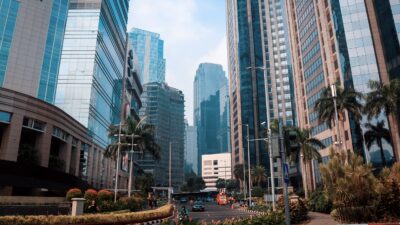Sydney Business Insights

Urban impact entrepreneurship
Innovation is crucial to solving the toughest problems raised by rapid urbanisation, problems like public transportation, urban poverty, homelessness or unemployment. Today such problems are tackled by urban impact entrepreneurs faced with all the challenges of any entrepreneurs, as well as a unique set of challenges that come with doing social urban innovation. We talk to May Samali, Director at Tumml, about how can we help entrepreneurs make our cities better.
Show notes and links for this episode
Interview sources
Research directly referred to in the podcast
JP Morgan and the Global Impact Investing Network (GIIN) Impact Investor Survey in 2016
Organisations directly referred to in the podcast
Other relevant articles on this topic written by May Samali
“Startups Can’t Afford to Ignore Government” (TechCrunch)
“Seeding Mission-Driven Startups” (Stanford Social Innovation Review)
Living Cities blog series – Part 1, Part 2 and Part 3
You can subscribe to this podcast on iTunes, Spotify, Soundcloud, Stitcher, Libsyn, YouTube or wherever you get your podcasts. You can follow us online on Flipboard, Twitter, or on sbi.sydney.edu.au.
Sydney Business Insights is a University of Sydney Business School initiative aiming to provide the business community and public, including our students, alumni and partners with a deeper understanding of major issues and trends around the future of business.
Share
We believe in open and honest access to knowledge. We use a Creative Commons Attribution NoDerivatives licence for our articles and podcasts, so you can republish them for free, online or in print.
Transcript
Sandra Peter Introduction: Innovation is crucial to solving the toughest problems raised by rapid urbanisation, problems like public transportation, urban poverty, homelessness or unemployment. Today such problems are tackled by urban impact entrepreneurs faced with all the challenges of any entrepreneurs, as well as a unique set of challenges that come with doing social urban innovation. How can we help them make our cities better?
Tumml is a San Francisco based urban ventures accelerator and Tumml's mission is to power entrepreneurs to solve city problems and scale these solutions to cities across the globe. So far, 38 start-ups have gone through their program and they have generated around 500 community jobs and have touched the lives of 3.6 million people.
Introduction: From the University of Sydney Business School, this is Sydney Business Insights. The podcast that explores the future of business.
Sandra: Today we are talking to May Samali who serves as Director of Tumml. May's areas of interest include venture financing, tech policy, urban innovation and social entrepreneurship. She has published on these topics, among others, in Tech Crunch, the Stanford Social Innovation Review and the San Francisco Chronicle. She holds a Master in Public Policy from the Harvard Kennedy School and the Bachelor of Law and the Bachelor of Economic and Social Sciences from the University of Sydney. Welcome, May.
May: Thanks for having me today.
Sandra: What is urban impact entrepreneurship?
May: Urban impact entrepreneurship means creating positive social impact through business models that are scalable and these business models sometimes use technology, sometimes they don't, and essentially they're serving city populations so that's where the kind of urban aspect comes in. Interestingly, across the US we have 81% of the population living in city environments and across the world two-thirds of the population are living in cities. What this means is that we have more and more urbanisation occurring and the problems associated with congestion and over crowdedness in cities mean that governments also are not able to respond to all of these challenges, like traffic congestion or unemployment or homelessness.
These urban impact entrepreneurs can step in and really help with creating innovative solutions that tackle the most pressing, hairy urban problems and we've seen a new wave actually of entrepreneurs that are sprouting up all over the country and not just in the US but globally and these entrepreneurs are combining their passion for solving problems that matter with business skills and the savviness associated with scaling an idea from the ground up.
I'm really excited to work with these entrepreneurs who are creating solutions that will stick and I guess the reason they're so important is that no longer can we rely on just governments and non-profits to solve these problems. They're becoming more and more complex over the years and so we need as many players involved in creating a multi-stakeholder approach and solution to the problem.
There's one example I want to use as a successful urban impact entrepreneur. Here in San Francisco is a company called "Chariot". Chariot's been around for a few years now and they actually came out of our Tumml accelerated program. They were acquired by Ford Motors just last year. They're a mobile based, crowd funded, commuter shuttle service that takes people from one end of the city to the other and the reason that this is such an exciting company is that they're serving areas insufficiently served by public transport but also private transit, where private transit like Lift and Uber might be too expensive for some members of the community. So Chariot being a transport start-up not only is solving a need of access to transport, really important needs so that the people in the San Francisco community can actually get to point A to B. But interestingly, it's solving a need for mostly socio economic under-served populations. For example, populations who need to be at work at very early hours of the morning because they're blue collar workers or are unable to access work because they live very far away, kind of in the east bay or even further out, and this transport solution is half the price of Uber and Lift, it's as on par with public transport options like BART and Muni, but also the people employed at Chariot are paid much higher than the minimum wage, they have job progression opportunities and they're doing some great work in helping create jobs and employment as well. So you see that in the example like Chariot as an urban impact enterprise is not only having operational impact, in that creating jobs and treating its workers well, but it's also having product impact where it's actually solving a real pressing problem on the ground that governments and non-profits have not been able to solve alone.
Sandra: That's fantastic and we hear a lot more about companies like Uber or Lift than about companies like Chariot. Why is it so difficult to be an urban impact entrepreneur?
May: In regards to what the actual difficulties are, I think we can separate them into three main categories. I spent the last couple of years at Harvard and as part of my research there, I actually studied urban impact entrepreneurs and surveyed them to better understand some of these challenges and from my research, I could actually find that the first category of challenges is really in relation to prejudicial attitudes. The common conception is that urban issues are the domain of governments, not start-ups, and so this strict divide between the role of the public and private sector stops a lot of these entrepreneurs from even starting a conversation with investors or with government because people say to them "You know nothing about the local population, you're not elected into power to do this, like why are you doing this?".
Similarly you've got the idea from a lot of early stage investors traditionally angel investors or venture capital funds that think you can't be creating profits and solving a social problem at the same time. You must by definition be compromising my profits if you're trying to solve a social problem. And so there's this perception, mostly amongst venture capital firms, that purpose driven investments cannot produce the hockey stick returns that they're looking. So that's kind of the first bucket.
The second category of challenges is in relation to acts as to early stage capital. So we can see that there's a lot of talk in the literature around the pioneer gap and this applies just as much to urban entrepreneurs as it does to start-ups in the developing world. What this pioneer gap means is that essentially businesses have to shoulder a financial burden in their early stages of pioneering new business models for social change. You see that these business models are sometimes unproven and therefore a lot of investors don't want to put money on the table because they are yet to see whether it's going to work or not.
Interesting statistics that kind of highlight the scale of this problem, so last year we had JP Morgan and the Global Impact Investing Network, they did an impact investor survey and as part of that survey they found that impact investors allocate only 4% of their capital to seed and start-up businesses. Really, this means that impact investors have a strong preference for investing in the later stage, so that's the growth stage where the business models tried and tested, it's already proven not to these urban impact entrepreneurs at the early stage that really need someone to believe in them and give them the money to try these models out. We also see that in terms of angel investors who are another big contributor of funding, only 5% of angels listed on the platform "Angel List" identify as being interested in mission-driven markets, which is a categorisation on the platform. There's a significant funding shortfall. This is a big problem because without seed capital these early stage companies cannot turn into the sustainable, scalable and successful companies we need to see in the world that can really change the dynamics of cities. And thirdly, the biggest difficulty going forward is that these urban impact entrepreneurs, they're bold, they're pushing the envelope but, by definition, they're also working in highly regulated industries.
So, the importance of being able to communicate and have a relationship and collaborate often with government is key and the reason it is difficult a lot of the time is that these entrepreneurs aren't just creating the next dating app and trying to get as many consumers on it, they're creating solutions to homelessness or to traffic congestion or to unemployment and so it's so important for them to be able to tap into the right aspects of government, to be able to get the right licences to operate, to be able to also see government as a scale-up partner and take a multi-stakeholder approach. The reality is that policies differ city to city so these urban impact entrepreneurs also face this challenge when scaling to new cities because you might have got it right in one city, say San Francisco, but if you're then taking your start-up, your urban impact enterprise to, say, Sydney Australia, you've got a whole new host of policy and regulatory and legal implications. So these are kind of the main things I think that are holding our entrepreneurs back.
Sandra: You mentioned government and regulators as having an important role to play - what is that role?
May: The role of government when it comes to start-ups is really two-fold. I think it's important to tease out that distinction. So the first type of relationship is the government as a customer of the start-up. So this is where there are civic tech start-ups, what we call where a start-up is directly providing a good or a service to a government agency and the government's a paying client. And often these solutions for government is enabling government to operate more efficiently or improve their service delivery. Really kind of a standout start-up in this space is actually the California headquartered start-up called "Shot Spotter" and their mission is to reduce violent gun crime. They do this by providing a subscription model and a technology solution for public safety agencies that help these agencies quickly locate and react to a legal gun crime and they help them recover evidence. This is a really good example of where government is actually buying the services of the start-up to help them fulfil their public mandate. Related to that you've got on the flip side the role of government as not just a customer but a collaborator or scale-up partner in a start-up.
So I mentioned that earlier where you have start-ups providing goods or services to the population that are filling a particular gap in services. These start-ups see themselves as complimenting or augmenting existing services. If we take the example of Chariot, you can see that Chariot not long exists to fill a need in public and private transit options at particular locations around the city but they're doing it in a way that's collaborating with government. So early on when Chariot was established they actually sat down with the authorities from the BART and Muni, which is here in San Francisco our bus and train system, and they discussed how they can make Chariot work in a way and on a timetable that then matched up nicely to the public bus and train systems so that when a community gets onto a Chariot bus, they go from A to B and get off at B and get directly onto the train that takes them to their next location. And so these are the two main roles for government.
Sandra: How can we then improve the landscape for urban impact entrepreneurs?
May: I think there's a number of steps that we can take, the actions we can take are directly linked to the difficulties that these entrepreneurs face. So, first and foremost, we need to provide more access to early stage flexible risk capital for these urban impact entrepreneurs. What that means is that we need more funders that are determined to not only have these entrepreneurs give them great returns but also see the ability for financial returns to come alongside social economic environmental impact. And this is often done by baking in the social impact into the business model itself. So, for examples, the more ‘communivan’ tickets that Chariot sells, the more people it's transporting, but also the more revenue it's creating. So, in that case, more revenue equals more social impact and this line of thinking helps get more money on the table for early stage enterprises.
We also need more governments to provide this risk capital to help fuel their innovative entrepreneurial eco systems and in some societies, for example in Australia, I think having more flexible legal structures, such as hybrid legal structures or low profit structures, will enable these entrepreneurs to access different types of capital and be a little bit more creative.
The second main change or improvement we need to make is in regards to the level of education and mentorship we have. There needs to be more lessons learnt and sharing across the spectrum. We need more communication and collaboration between entrepreneurs and investors, both traditional investors and impact investors, on how to pitch, how to grow your business model, how to scale, how to work with regulators and also mentorship between more traditional tech companies and urban impact entrepreneurs. They're going through the same entrepreneurial methodologies and they're coming against the same hardships and needing to answer the same questions so there's a lot of opportunities to have engagement and collaboration and lessons learnt.
The third improvement we can make for the landscape for urban impact entrepreneurs is to build more collaborative partnerships between governments and entrepreneurs. So this kind of relates to my earlier point around mentorship and education but really we need governments to bring more entrepreneurs into the policy design process and get entrepreneurs at the table and for these two main two stakeholders combat issues such as homelessness together and think about where their strengths and weaknesses lie and how they can collaborate on these issues moving forward, rather than just having governments saying no to entrepreneurs or for entrepreneurs on the flipside to say "I don't want to work with government because they're the enemy". Rather, they can be allies and together have the maximum social impact possible.
Sandra: What advice would you give people who are thinking about urban impact entrepreneurship?
May: First and foremost I want to say that urban impact entrepreneurship is a very exciting area to be working in and to be investing in and I encourage everyone who's interested in urban innovation, urban development, entrepreneurship, passion with a business model essentially, to get out there and give it a try. But to do it successfully there are three main lessons that I want to share and these lessons really come from my experience working with companies here at Tumml but also companies I've worked at during my time at Harvard and through my research process, kind of the lessons learnt and best practices.
So the first lesson is that entrepreneurs and urban impact entrepreneurs in particular need to be scrappy and creative. What this means is that they need to be very creative in how to pull together bits and pieces of capital in order to fund their start-up initially. Early stage capital is really hard to find for these entrepreneurs and so they need to do their homework and there's ways of being creative. So, for example, government grants are one really good opportunity for a pool of funding to come in where the benefit of a lot of these government grants is you can get huge pools of capital without giving away any equity or ownership in the company. And we have a company here who went through our program called "Sky Cool Systems", they produce roof panels that improve the efficiency of cooling and refrigeration systems and they're actually entering the market for supermarket refrigeration. Supermarket refrigeration aisles are the biggest users of energy in city environments in this retail space and so their solution cuts down on energy costs but also saves the environment. The way they've been able to fund their business over the last year is through a million dollars in non-diluted funding and this has come from a couple of different agencies including the Advance Research Projects Agency for Energy in the US or the National Science Foundation's Small Business Innovation Research Program. But doing your research means that you can tap into these pools of funding.
Crowd funding is another way to be scrappy and this is particularly important for hardware start-ups. For example, we had a company called "Hive Lighting". Hive Lighting produce high output, high performance, energy efficient lights for commercial and personal use and they're actually doing some really great work. They're based out in LA, which means the mass market is the entertainment market, they're featured in many films and many movies and in fact they were just last year nominated for an Academy Award for their technology, and they wanted to take their lights to other markets. So they want to take these lights into museums, into municipal markets, into stadiums. But they needed more capital. So they built these really effective kick starter campaign, which I had the privilege of working with and through their kick starter campaign were able to raise almost half a million dollars just in a two-month period and their goal was only $35,000. So when we talk about scrappy and creative, it doesn't just mean that your product has to be scrappy but ways that you collect money can be.
The second piece of advice I want to give to urban impact entrepreneurs is something that we've talked about a couple of times throughout this interview is that government is an ally and a partner and we should really see them in that way. Of course there are exceptions to this rule but on the whole governments are usually happy to have conversations with entrepreneurs, particularly entrepreneurs that want to help them solve problems that these city governments are mandated to solve. And the importance of working with government is often the difference between surviving or dying as a start-up.
Now let's go back to the example of Chariot. As we discussed, Chariot the commuter, crowd-sourced van is doing really well, its revenue and customer base has grown, it's solving a real problem, it's been acquired, and it’s scaling to other cities across the US. But if you rewind back three years when Chariot first started, there was an exact competitor to Chariot called "Leap". Now Leap looked, sounded like and, for all intents and purposes, was exactly the same as Chariot. What they were doing differently though is the way in which they were collaborating, or I should say not collaborating with government. So, on one hand, Chariot, before they launched their product, went and talked to the officials at the public sector agencies, the BART and Muni, and came up with a really good game plan for how they can coordinate their services, together tackle this big problem of traffic congestion, lack of access to transport and, as a result, got the necessary licenses and have grown and thrived and, in fact, the local government here in the Bay area really like Chariot.
On the other hand, Leap faced a cease and desist order from the California Public Utilities Commission when it started operating because it had actually done so without getting the official licenses and it hadn't actually considered disability access and so it was violating these regulations so this one simple example demonstrates the real importance of working with government, not just making sure you've got the necessary licenses, but also taking a more proactive approach to starting a conversation.
And the third lesson is to focus on execution. The start-ups that have done really good work and been able to access capital and have impact in the communities within cities are those that not just focused on idea generation but on getting there and implementing their ideas. Funders don't actually go easy on urban impact entrepreneurs just because they're doing something good. They want to see metrics in the same way they do for every other start-up.
So I would really caution against this dependency on values over value. You have to show that you're producing financial value. But you've also got users and customers. You've got financial metrics and operating milestones and that it's not just a person with a big heart. That is the big differentiator - start-ups that are able to get out there and get proof points, get runs on the board, come back to the drawing table, iterate, make sure their product is reflecting what the customers actually want, are the ones that are most going to succeed. And we saw this again with Chariot where, within 10 weeks, the founder, Ali, was able to get a van, be able to set up a system of drivers that were taking people from A to B, getting van pool insurance, getting a gasoline line of credit, getting parking, building a really basic website, taking credit card payments, sounds like a big list of tasks. He did this in just 10 weeks. So, focus was on execution, not getting the product right from the start but getting out there and doing it and coming back and re-evaluating.
Sandra: You are so passionate about this topic. How will you contribute to urban impact entrepreneurship in your career?
May: My goal, I think, in the longer term is to bring this idea of urban impact entrepreneurship and really mission and purpose driven business into the mainstream. It shouldn't be an exception to the rule or a siloed industry, it should be something that is part and parcel of the way that we do business and think about solving social problems. This for me means engaging in two main lines of work. At a micro level, I'm determined to continue to work as an investor and adviser to these entrepreneurs, and at the macro level, what it means is spearheading eco system building activities. So to be able to really enable these businesses to fulfil their true potential through giving them better access to capital networks, giving them more supportive legal and regulatory infrastructure so there's a bit of policy and lobbying work there, really looking forward to continuing this type of work and really encouraging everyone to be involved.
Sandra: We look forward to hearing more about it. Thank you so much for talking to us today.
May: Thanks so much for having me today, it's really been a pleasure.
Outro: You've been listening to Sydney Business Insights, the University of Sydney Business School podcast about the future of business. You can subscribe to our podcasts on iTunes, SoundCloud or wherever you get your podcasts and you can visit us at sbi.sydney.edu.au and hear our entire podcast archive, read articles and watch video content that explore the future of business.
Close transcript







